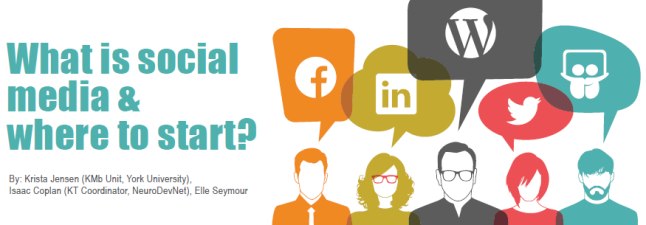By Anneliese Poetz, KT Manager, Kids Brain Health Network
Almost two years ago I took a creative writing course. I didn’t expect at that time that it would be so relevant to Knowledge Translation, but I have come to realize that it really is.
 I remember during graduate school, as researchers-in-training we were taught to be able to ‘tell the story’ in our data, meaning, how think analytically or be able to describe the patterns in your data. Being able to tell the story that your data were telling you was necessary no matter whether it was a quantitative (statistical analysis of numerical data) project or qualitative (analysis of words, text). But beyond this, when it comes time to tell the story of your research project as a whole, you need to become Batman.
I remember during graduate school, as researchers-in-training we were taught to be able to ‘tell the story’ in our data, meaning, how think analytically or be able to describe the patterns in your data. Being able to tell the story that your data were telling you was necessary no matter whether it was a quantitative (statistical analysis of numerical data) project or qualitative (analysis of words, text). But beyond this, when it comes time to tell the story of your research project as a whole, you need to become Batman.
“Becoming Batman” means you can think of yourself as the protagonist (see #4 below) in the story of your research project when you are developing your messaging for your KT products. The KT Core recently produced an Infographic Guide. It requires the research team to sketch out the ‘story’ they want to tell about their research. It occurred to me post-production that maybe some further pointers were needed for how to do that, and became the inspiration for this blog post.
Whenever we create KT products, it is usually the hope that it will inspire and inform changes; either in policy, practice or individual behaviours and attitudes. In my creative writing class we were taught about ‘the poetics’ or the 4 ‘unities’ or ‘elements’ of any great story, no matter how it is told: in a book, a play, a movie, etc. In each great (popular) story, all 4 elements are present. These four elements and how they relate to telling a compelling story about your research that motivates people to take action are:
 1) Time: how much time is being covered in your story? With respect to your research project, how long as the problem (see: #4 antagonist) under study been an issue?
1) Time: how much time is being covered in your story? With respect to your research project, how long as the problem (see: #4 antagonist) under study been an issue?
You need a containable frame of time. What was the time frame for your study? Is there a timeline?
Was there a short timeline within which you had to solve this problem? What were the macro segments of time (the overall timeline from beginning to end) and what were the micro segments of time (time it took to interview respondents)?
You need to decide what will be the beginning of the story, and what will be the end. Make the time frame clear. Will you start to tell the story from before the project began, when you consulted with stakeholders to find out what they needed and formulated the research questions in order to figure out what the solutions could be? Or will you start telling the story from when you successfully received a research grant to investigate your questions? Is this something that occurred in the past? Over the past week? Over years? Are you telling the story in past tense or present tense?
Be aware of how much time (e.g. in a video) or space (in an infographic) you have to tell your story – if you only have a small amount of time or space, you are bound by that so keep the story within these constraints. You can’t cover everything, and the amount of time or space will never be enough. But make a decision what you actually want to cover.
 2) Place: In your story, where is your research taking place? Place is very important to the story, is it clearly defined or mentioned? How has ‘place’ affected you and your role in the story of your research? What are the people like? How has it influenced who you are, how you do your work? Make sure your interaction with ‘place’ is part of the story you are telling.
2) Place: In your story, where is your research taking place? Place is very important to the story, is it clearly defined or mentioned? How has ‘place’ affected you and your role in the story of your research? What are the people like? How has it influenced who you are, how you do your work? Make sure your interaction with ‘place’ is part of the story you are telling.
 3) Antagonist (villain): you can’t write a story without an antagonist, the antagonist is absolutely crucial to your story. But in your research project you won’t be talking about how (you as) Batman defeated the Joker. An antagonist in a research project can be an illness, disease, societal issue you want to understand or solve, or a phenomenon (like a discovery you want to make). Describe what your antagonist is. What is the problem you are investigating? Is your antagonist internal (you are struggling to overcome your own curiosity, your personal issues and/or health problems) or external (are you investigating a community or societal issue, an environmental plague, outer space, etc.)? It should be readily apparent to the reader what it is you are up against.
3) Antagonist (villain): you can’t write a story without an antagonist, the antagonist is absolutely crucial to your story. But in your research project you won’t be talking about how (you as) Batman defeated the Joker. An antagonist in a research project can be an illness, disease, societal issue you want to understand or solve, or a phenomenon (like a discovery you want to make). Describe what your antagonist is. What is the problem you are investigating? Is your antagonist internal (you are struggling to overcome your own curiosity, your personal issues and/or health problems) or external (are you investigating a community or societal issue, an environmental plague, outer space, etc.)? It should be readily apparent to the reader what it is you are up against.
How did you (or are you planning to) overcome it? This will be your research methods.
 4) Protagonist: The protagonist is the ‘hero’ or main character. This would be you, the researcher. You are Batman. You and your research team are working towards overcoming the ‘antagonist’ or problem you are investigating.
4) Protagonist: The protagonist is the ‘hero’ or main character. This would be you, the researcher. You are Batman. You and your research team are working towards overcoming the ‘antagonist’ or problem you are investigating.
How are you different now at the end of the project than you were at the beginning? What did you learn? Discover?
You can’t have a little of both – it is absolute – you either overcome the antagonist or you succumb to it. Did you overcome the antagonist (solve the problem you were investigating, make the discovery, answer your research questions) or did you succumb to it (the project did not yield results and further research is needed)? In storytelling this is known as the cathartic ‘release’, the recipient of your story is waiting to see whether it is going to be one or the other, and gets the same amount of pleasure out of the story whether you succeeded or failed. The reason why people are interested in your story is to find out what happened, to get that cathartic experience. In order to motivate the reader to action, you need to find a way to get that emotional reaction.
You have a fascinating research project. The trick is to be able to convey what’s important to you about your research, to someone else. What is at stake for you? For society? Make sure the stakes are high enough, this makes the story more compelling. What would happen if you hadn’t done this research project?
Food for thought for the next time you create an infographic (or really any KT product). What is the story you are telling? Does your ‘story’ evoke an emotional reaction? If the answer is yes, you will be more likely to motivate the reader toward action (e.g. changes in policy, practice, and/or personal behaviour) and isn’t that the reason why we do KT?





 A TEDx event is not an easy thing to coordinate or one that can be developed in only a few months time. You will need dedicated personnel; we have one person (JL) who is dedicated to coordinating all aspects of the day over a 12 month period, for about one day a week. Our timeline was as follows, based on our capacity:
A TEDx event is not an easy thing to coordinate or one that can be developed in only a few months time. You will need dedicated personnel; we have one person (JL) who is dedicated to coordinating all aspects of the day over a 12 month period, for about one day a week. Our timeline was as follows, based on our capacity: As you begin this goal setting and visioning process, read the guidelines to know what goals are feasible. The
As you begin this goal setting and visioning process, read the guidelines to know what goals are feasible. The  Looking for an appropriate venue, we kept in mind not only costs but accessibility for families – as well as technical requirements for our event (e.g. lighting, staging). With the depth and breadth of enthusiastic, passionate Canadian researchers, advocates and parents available, we had no difficulty finding individuals who could fit the TED requirements. Our speakers are up for the challenge, currently being coached to chiselling their passion, knowledge and experience into a tight 8 minutes. Similarly, finding partners and sponsors for the event was not a big challenge. Many organizations that shared the same vision of KT and gladly supported us, including the
Looking for an appropriate venue, we kept in mind not only costs but accessibility for families – as well as technical requirements for our event (e.g. lighting, staging). With the depth and breadth of enthusiastic, passionate Canadian researchers, advocates and parents available, we had no difficulty finding individuals who could fit the TED requirements. Our speakers are up for the challenge, currently being coached to chiselling their passion, knowledge and experience into a tight 8 minutes. Similarly, finding partners and sponsors for the event was not a big challenge. Many organizations that shared the same vision of KT and gladly supported us, including the 

















 One thing that I should also mention is the power of
One thing that I should also mention is the power of 



